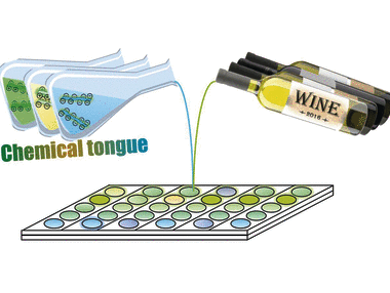Fluorescence-based Assay System Detects Different Types of White Wine
Swirl, sniff, sip, and swallow: Discrimination of different wines has always been a matter of tongue and taste. Is objective and reliable discrimination of the thousands of wine varieties possible by means of a simple chemical analytics kit? Scientists in Heidelberg, Germany, say yes, and in the journal Angewandte Chemie they present two polyelectrolyte semiconductors that in combination form a simple fluorescence-based analytical technique to discern at least thirteen white wines.
Chemical wine analytics traditionally aims to identify illegally added substances or to quantify certain ingredients. Besides, there is a broad sensory science for wine that distinguishes the wines just by sight, smell, taste, touch, and hearing, but the decisions are, after all, subjective. Seeking a more objective basis, Uwe Bunz and his team employed sensors to chemically fingerprint the wines. Such a fingerprint reflects the composition of the wine including alcohols, sugars, acids, vitamins, nutrients, and the plethora of secondary plant products like flavonoids, tannins, etc. However, as the latter in particular number in the thousands, conducting an exhaustive chemical analysis is difficult.
Thirteen Wines Differentiated by this Chemical Tongue
Therefore, Bunz and his team turned to a simple colorimetric assay based on the fluorescence response of a certain type of colored polyelectrolytes, poly(p-phenyleneethynylene)s (PPEs). These soluble and charged polymers respond to the typical wine ingredients such as colorants, sugars, and acids. “The fluorescence response of the sensor elements to the wines is primarily due to the wine colorant,” the researchers explain. As white wines contain colorants, the scientists obtained strong but varied fluorescence quenching, and its modulation was mainly caused by the sugars and acids present in the wine.
The scientists remark that a small set of two PPEs and their complex was sufficient to obtain a simplified but reliable fluorescence response pattern as a specific fingerprint. All of the 13 tested white wines were discerned by their specific fingerprint. “Only one of 52 unknown wines was misclassified, representing an accuracy or 98 %,” the authors wrote.
However, only for the Riesling wines an assignment of the grape from which the wine was produced by the wine fingerprint was possible. The researchers presume that the different strains of yeasts used to make the wines have an additional large influence on the chemical composition of the products, more so than the grape type. It appears that identifying the grape will indeed remain a matter of taste.
- Two Oppositely Charged Poly(p-phenyleneethynylene)s and Their Complex Discriminate White Wine,
Jinsong Han, Markus Bender, Kai Seehafer, Uwe H. F. Bunz,
Angew. Chem. Int. Ed. 2016.
DOI: 10.1002/anie.201602385


